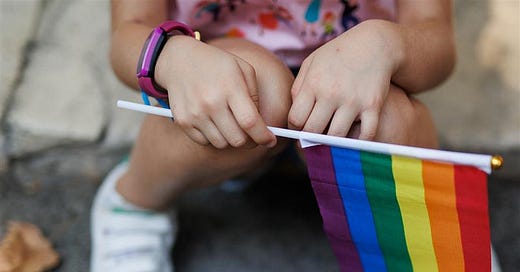How To Talk To Your Children About Pride
Fighting for the rights of our LGBTQ community is as important today as it was when the Stonewall Riots of 1969...
Talking to your children about LGBTQ+ people and experiences shouldn’t be something that only happens during Pride Month. Ideally, you are showing your toddlers and young kids picture books that feature different kinds of families, such as two Mums, two Dads or queer solo parents, and as they get older they should be discovering LGBTQ characters in stories for themselves.
But the prevalence of rainbow flags at this time of year is a good opportunity for an age-appropriate conversation and a reminder that Pride isn’t all cupcakes and unicorns, but is a protest. Fighting for the rights of our LGBTQ community is as important today as it was when the Stonewall Riots of 1969 started what we know now as Pride.
Here are my tips for creating an open and honest dialogue with children of all ages on this subject.
Do Say ‘Gay’…
… and ‘lesbian’ and ‘queer’ and ‘bisexual’ and ‘trans’ - these are not dirty words but they come laden with a murky sense that they are somehow inappropriate for children. It’s important to normalise the language around LGBTQ+ identities - these are not words that need to be whispered or avoided, and if you find yourself struggling to say them around young people it’s important that you ask yourself why and interrogate your own unconscious heteronormative biases. A nice activity could be to look at a Pride flag together and find out what each of the different colours of the rainbow represent for the LGBT community.
While it’s great that your child feels proud of their school work, for example, talking generally about what makes us feel ‘proud’ can be an easy way for people, and especially schools, to avoid facing LGBTQ+ topics head on. Discussing what we are individually proud of and what ‘pride’ feels like are useful ways into talking about LGBT Pride, but take care that they don’t become convenient ways to avoid addressing queerness in all its forms directly. It’s one thing feeling proud that you won a race, another to feel proud to be a part of a marginalised community. Making this distinction to our children is important.
2. Encourage curiosity and open-mindedness
As we confront our own biases and preconceived ideas about the world as adults, we really need to work hard not to pass these on to our children and instead foster a spirit of openness and understanding. Try integrating ‘they/them’ pronouns into play and imaginary games. Could the dinosaur be non-binary? Hell yeah! When talking about new people or making observations make an effort to un-gender your language; talk about a child’s ‘grownups’ or ‘parents’ instead of ‘mum and dad’. Using they/them pronouns until you know someone’s gender for sure is also good practice.
Pride month is a great chance to talk about identity with your child - everyone is different and we listen and respect who they tell us they are. It’s as simple as that. This could also be a good time to remind your child that you don’t make any assumptions about the gender of the partner that they may or may not one day choose.
3. Ask your school or nursery what they are doing for Pride Month
It shouldn’t just fall to LGBTQ+ parents to organise pride events or assemblies. Maybe you know someone who could be a good speaker for an event at the school and you could make a connection, or you could bring in some books for them to have on display in the classrooms this month and beyond. Obviously I am going to have to recommend my own book My Magic Family here, as it is perfect for Nursery and Key Stage One-age kids. It’s about a little girl with two mums who discovers the magical ways all her friends’ families are different too. Here is a great list of other LGBTQ+ Picture books:
Who’s Your Real Mum?
My Daddies!
Covered in Adventures
Bathe the Cat
Grandad's Camper: A picture book for children that celebrates LGBTQIA+ families
4. Don’t shy away from difficult conversations with kids
As your children get older expect to be challenged on your own prejudices. Even if you think you are an LGBT ally, your child may pull you up on language or assumptions. Try not to be annoyed about this but to see it as a chance to ask them questions and learn from them.
One example of a difficult conversation happening in families around the world right now involves talking to your child about the author of the Harry Potter books - J.K. Rowling, who’s views on the transgender community are well known. It is up to each individual to decide for themselves how they feel about that, and whether they can enjoy her books knowing her stance. You could be inspired this Pride month talk to your child about the views Rowling holds, and how that impacts trans people. Children are critical thinkers and even if they still love the series, this context is important to share.
When Rowling posted to social media after the recent Supreme Court Ruling - which has made life even harder for trans people - my seven year-old took one look at the selfie of her smoking a cigar on a yacht with the caption ‘I love it when a plan comes together’, and said “I’m not into wizards anyway”.
5. Go to a Pride Parade!
News flash - you don’t have to be LGBTQ+ to go and have fun at a Pride celebration - allies are welcome! The children’s area at Pride celebrations will be a beautiful safe space for your family to explore and make new friends. All sorts of people in fabulous outfits march at Pride (or just go to party) so you’ll have lots of opportunities to talk to your children about who they’ve seen and what they’ve experienced.
If you want to find out more about LGBTQ+ life, love and culture today, my new book with Stu Oakley Do Ask, Do Tell answers every question you’ve ever wanted to ask. It’ll certainly help you speak to your children about what Pride means and why it matters.







